Foreign Insulators
by Marilyn Albers
Reprinted from "Crown Jewels of the Wire", June 2000, page 41
NEW INSULATOR STYLES FROM ABROAD
The first two insulators you see here have the same profile but the one on
the left in the photo is white porcelain and the insulator to the right is made
of light straw colored glass. Guido Boreani, our foreign insulator expert, says
that both types were used on Italian State Telephone lines.
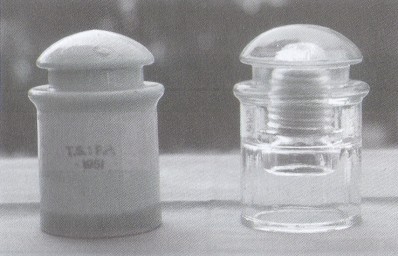
Seeing double
The oval trademark
of RICHARD GINORI is ink stamped on the dome of the porcelain piece and the
letters "T.S.l.F.P." followed by a "1951" date can be seen
on the skirt. "T.S." stands for Telefoni de Stato, or State Telephone.
We are not sure what "l.F.P." stands for. A 3/8" light blue band
circles the skirt right at the base of this piece to indicate that it was used
as a marker insulator for use on a special line which in this case was the State
Telephone of Italy. The insulator is 4" in height and has a base diameter
of 2-1/2". It has an inner skirt and a threaded pin hole. The profile is
similar to U-1185 but I'm sure it will need a U-number of its own.
The glass
insulator to the right in the photo has just been classified as new CD 406.
"PYREX" (over) "1950" is embossed on the front skirt and "T S MOD 1 F P" appears in the same location on the opposite side.
The measurements of this insulators are almost identical to those of the
porcelain example described just above, including an inner skirt and threaded
pin hole. The "1950" date of manufacture indicates that the glass
insulator was made a year before its porcelain twin. This new CD 406 is similar
to CD 407, which has already been published in Glass Insulators from Outside
North America, but the profile of this new PYREX style is just enough different
to warrant its new CD number.
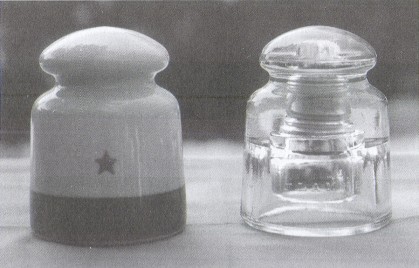
Another set of insulator twins from Italy
The porcelain insulator on the left in the photo is a U-1248. The oval
trademark of the Italian factory known as Richard Ginori is stamped on the dome.
I've seen a few examples of this style but this particular one is most unusual.
The insulator has a white glaze and the 3/4" band you see circling low around the
skirt is a pretty Christmas green with golden yellow threads all through it. The
"Star" just above the band is also a mixture of gold and green. It's a
beautiful insulator and it's in perfect condition. At first glance you'd think
it was hand painted by an artist but that can't be true because Guido Boreani
(our Italian insulator expert from Milan) actually took this one down from the
line. He says that these insulators are rare now because they were produced only
during the years 1952-1960 and the open wire lines were being dismantled soon
after the insulators were put in service. He was indeed fortunate to find an
example that had been left behind.
The glass twin to the right in the photo is a
CD 444 made of straw colored glass. It's also a very attractive piece. Both of
these insulators, the porcelain and the glass, have inner skirts with threaded pin holes and their
exterior profiles are identical. They are 3-1/4" tall with base diameters
of 2-3/4". "FLAMREX" is embossed on the skirt of the glass insulator
followed by a production date of "1967". We don't know the significance
of the word "FLAMREX", but the glass of which the insulator is made is
very much like PYREX glass so it is bound to be a sturdy insulator.
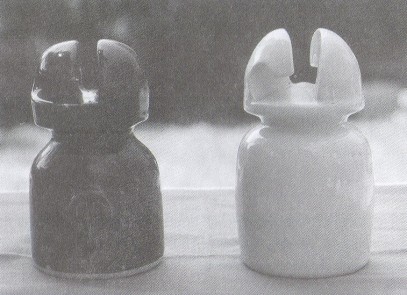
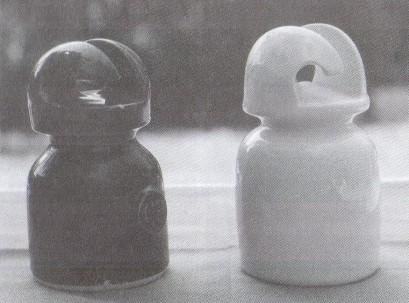
Two extraordinary insulators
Here we have two similar porcelain insulators each with a "twist
lock" feature built into the crowns. One view shows them looking straight
at you and the other view shows them at an angle. The brown glazed insulator on
the left was found by Ulrich Reiser of Neckartenzlingen, Germany. It is 5-3/8" tall and has a base diameter
of 3-1/8". Notice the protruding one
inch "belly button" on the front skirt. The raised letters "C.P."
are right in the center of it! Ulrich found this insulator and he thinks the
letters may stand for "Correio (de) Portugal" or "Portuguese Mail
Service". Elton Gish, our American porcelain insulator expert, said that he
had never seen one like this.
The white porcelain insulator you see to the right
in both photos is one I have had on my collection for quite a long time. Very
faint letters are incused on both sides of the crown and they are almost
impossible to read but as best I can tell they are "G.S.G.D.G." (over)
"J.D." (over) "W.O.B.C." on one side with possibly these
same letters on the opposite side. Trying to make them out is just about
impossible. I've never known where this piece was made or found or used so it
remains a mystery. The insulator was classified as U-2017 back in 1986 when Jack
Tod and I co-authored the Worldwide Porcelain Insulators book, and that number
remains so, but the profile of this newly discovered "C.P." insulator
is quite a bit different from that of U-2017, so I see no reason not to give it a
new number. It will happen.
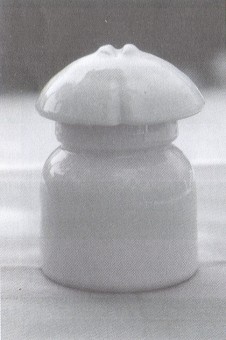
Czech coolie hat
Here are two views of a little white porcelain
insulator with a purpose similar to the British U-1938A's and U-1941's used in
England, except that it's much smaller and has an entirely different profile. As
you can see in the photo on the next page, the cap screws off to reveal a short
threaded post in the center of the space just under the cap that's packed with
tar soaked fibers of some kind. This one is called a "Dry Spot"
insulator because the wire comes up through a hole in the insulator, then runs
across to an open slot on the opposite side where it remains protected from the
moisture until it comes down and out to the next insulator on the line. Notice
that little slot on the left side of the insulator's top rim. As long as the wire follows this path it will always
have a dry spot.
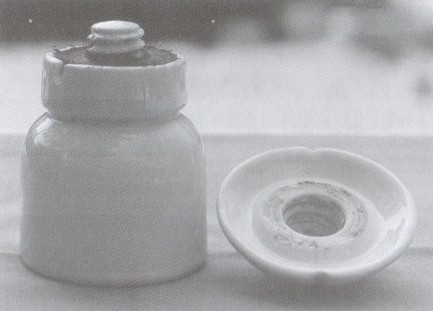
Czech coolie hat with cap unscrewed
. Ulrich Reiser says "I found the insulator on the 22nd of
May, 1998 in Tschechia halfway between the town of Pilson (famous for its beer)
and Prag. As Tschechia had no insulator factory near by, I suppose that this
little "Czech Coolie hat" insulator was produced in Germany. I have no
idea who made them and I couldn't find this kind in any of the old
catalogs."
Our Crown Jewels of the Wire readers are indebted to both Guido
Boreani of Italy and Ulrich Reiser of Germany for the valuable information they
have provided.
| 